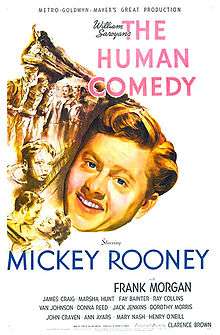The Human Comedy (film)
| The Human Comedy | |
|---|---|
 Film poster | |
| Directed by | Clarence Brown |
| Produced by | Clarence Brown |
| Screenplay by | Howard Estabrook |
| Story by | William Saroyan |
| Starring |
Mickey Rooney Frank Morgan |
| Narrated by | Ray Collins |
| Music by | Herbert Stothart |
| Cinematography | Harry Stradling |
| Edited by | Conrad A. Nervig |
| Distributed by | Metro-Goldwyn-Mayer |
Release dates |
|
Running time | 118 minutes |
| Country | United States |
| Language | English |
| Budget | $1.0 million[1][2] |
| Box office | $3.9 million[1][2] |
The Human Comedy is a 1943 American drama film directed by Clarence Brown and adapted by Howard Estabrook.[3] It is often thought to be based on the William Saroyan novel of the same name, but Saroyan actually wrote the screenplay first, was fired from the movie project, and quickly wrote the novel and published it just before the film was released.[3] It stars Mickey Rooney with Frank Morgan. Also appearing in the film are James Craig, Marsha Hunt, Fay Bainter, Ray Collins, Van Johnson, Donna Reed and Jackie 'Butch' Jenkins.
The film is the story of a teenaged Homer Macauley (Mickey Rooney) in high school, working part-time as a telegram delivery boy, in the fictional town of Ithaca, California, during World War II. The effects of the war on the "Home Front" over a year in Homer's life are depicted in sentimental scenarios involving himself, his family, friends, and neighbors, and acquaintances encountered. The storyline is directed by a narrator, Homer's deceased father (Ray Collins).
Cast
- Mickey Rooney as Homer Macauley
- Frank Morgan as Willie Grogan
- James Craig as Tom Spangler
- Marsha Hunt as Diana Steed
- Fay Bainter as Mrs. Macauley
- Ray Collins as Mr. Macauley
- Van Johnson as Marcus Macauley
- Donna Reed as Bess Macauley
- Jack Jenkins as Ulysses Macauley
- Dorothy Morris as Mary Arena
- John Craven as Tobey George
- Ann Ayars as Mrs. Sandoval
- Mary Nash as Miss Hicks
- Henry O'Neill as Charles Steed
- Katharine Alexander as Mrs. Steed
- Alan Baxter as Brad Stickman
- Darryl Hickman as Lionel
- Barry Nelson as Fat
- Rita Quigley as Helen Elliot
- Clem Bevans as Henderson
- Adeline De Walt Reynolds as Librarian
Robert Mitchum and Don DeFore appear uncredited in early bit parts as buddies of a soldier Barry Nelson with a night off from training, trying to meet girls and take in a movie. Carl Switzer, best known as "Alfalfa" in the Our Gang shorts, appears uncredited as Auggie, a friend of Ulysses.
Production
Saroyan wrote a film treatment and a screenplay that he was asked to direct. He was paid off and removed from the project when his film proved to be more than two hours long. Saroyan was not at all happy with the film as completed by Brown, and he wrote his novel from the script he produced.[3] The novel was published at the same time as the film's release with the intent of countering the film version of the story. There are noticeable differences between the film and the novel, including a stronger characterization of Ulysses, the small boy, in the novel and far fewer scenes of sentiment than were incorporated into the film by Estabrook and Brown (social criticism is also much blunter in the novel). Louis B. Mayer, head of MGM, who suggested that this was his favorite film, also suggest a very definite "MGM house style".[4]
Reception
The New York Times reviewer praised the film's performances, especially Rooney, saying that "There is a tenderness and restraint in his characterization." But he chided the film for excessive sentimentality, saying it featured "some most charming bits of fine motion-picture expression and some most maudlin gobs of cinematic goo."[3]
The film made $2.8 million in the US and Canada and $1.0 million elsewhere resulting in a profit of $1.5 million.[1][2][5]
Awards
It won the Academy Award for Best Story and was nominated for Best Actor in a Leading Role (Mickey Rooney), Best Cinematography, Black-and-White, Best Director and Best Picture.[6]
References
- 1 2 3 The Eddie Mannix Ledger, Los Angeles: Margaret Herrick Library, Center for Motion Picture Study.
- 1 2 3 Scott Eyman, Lion of Hollywood: The Life and Legend of Louis B. Mayer, Robson, 2005 p 349
- 1 2 3 4 Crowther, Bosley (March 3, 1943). "Movie Review: The Human Comedy". The New York Times. Retrieved August 19, 2008.
- ↑ "Rotten Tomatoes: The Human Comedy". Rotten Tomatoes. Retrieved March 1, 2014.
- ↑ "Top Grossers of the Season", Variety, 5 January 1944 p 54
- ↑ "The 16th Academy Awards (1944) Nominees and Winners". oscars.org. Archived from the original on October 14, 2013. Retrieved October 4, 2013.
External links
| Wikimedia Commons has media related to The Human Comedy (film). |
- The Human Comedy at the American Film Institute Catalog
- The Human Comedy at the Internet Movie Database
- The Human Comedy at the TCM Movie Database
- The Human Comedy at AllMovie